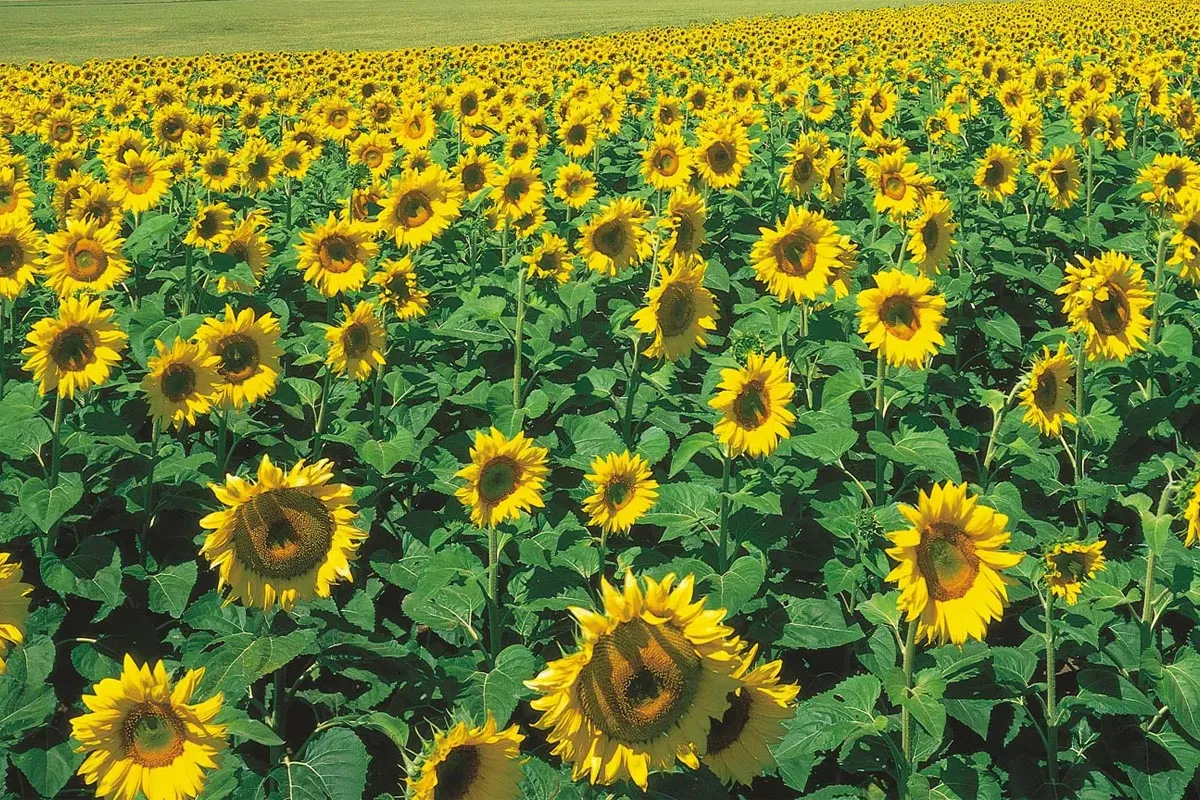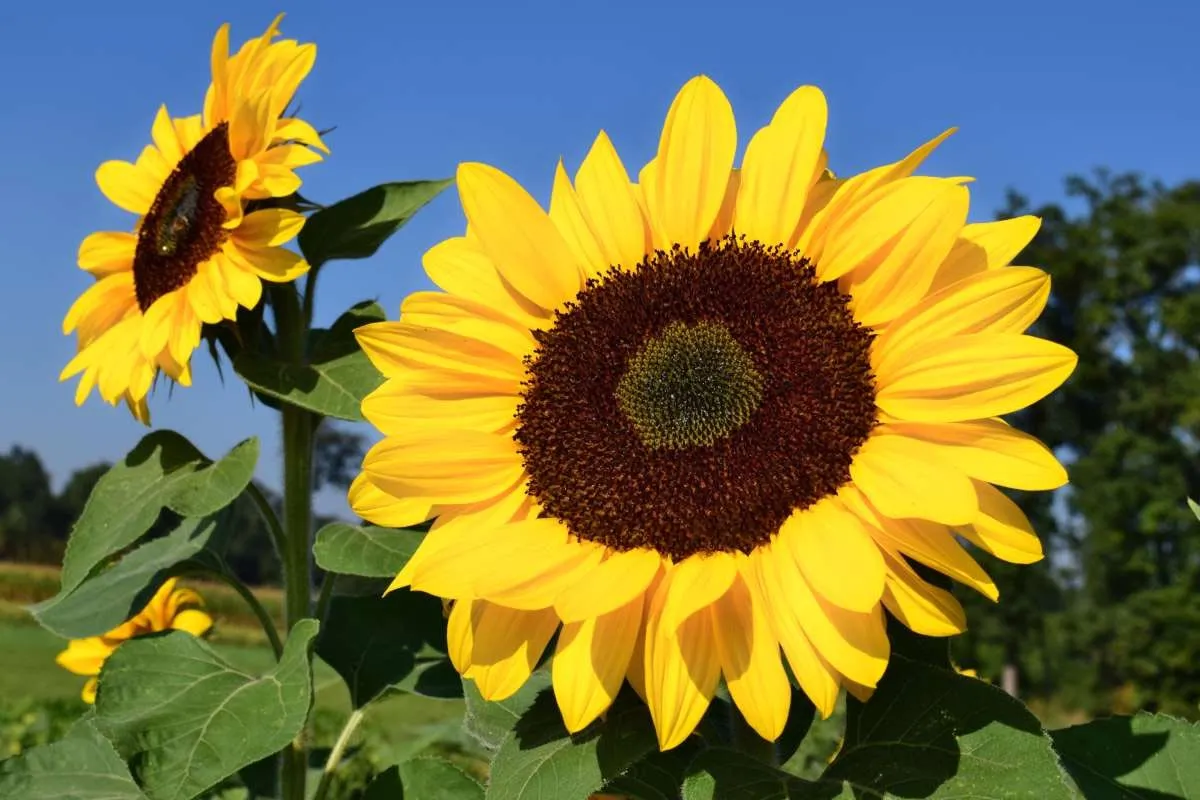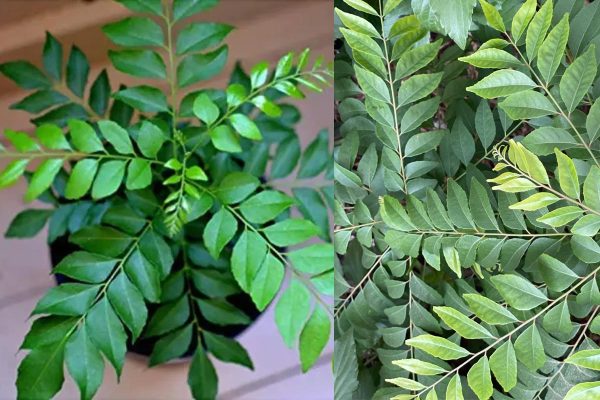Plants
Sunflower
Introduction / परिचय
The annual plant of the sunflower (Helianthus annuus) boasts a substantial daisy-like flower face. Derived from Greek roots, its scientific name, Helianthus, fuses "helios" (meaning "sun") and "anthros" (meaning "flower"). While these flowers exhibit a range of hues (Cream to Gold, Yellow, Orange, Red, Mahogany and Chocolate Brown), the familiar bright yellow petals encircle brown centres that mature into weighty heads laden with seeds. Sunflowers are ideal for floral arrangements, attracting pollinators – bees, birds, and butterflies. Beyond their aesthetic appeal, they serve as superb-cut flowers, adding a touch of nature's radiance to various settings.
Also Read This :How to Grow Sunflower from Seeds At Home
| English Name: | Sunflower |
| Hindi Name: | सूरजमुखी (Surajmukhi) |
| Scientific Name: | Helianthus |
| Family: | Asteraceae |
| Kingdom: | Plantae |
| Light : | Full Sun |
| Height: | 1-12 feet tall. |
| Flower Color : | Cream to Gold, Yellow, Orange, Red, Mahogany and Chocolate Brown |
| Leaves Color : | Light Green to Deep Green |
| Eason Features : |
Also Read This :Greening Your Home: The Benefits of Indoor Plants
When to Plant Sunflower
The timing for planting sunflowers (Helianthus annuus) depends on your location and local climate. Generally, sunflowers are warm-season plants that thrive in full sun and require frost-free conditions for optimal growth. Here's a guideline on when to plant sunflowers based on different regions:
Spring Planting
In regions with distinct seasons and cold winters, wait until after the last frost date to plant sunflowers. This is usually in the spring when the soil has warmed up, and the risk of frost has passed.
Warm Climate Planting
I live in an area with mild winters and a long growing season. You can plant sunflowers earlier, even in late winter or early spring.
Summer Planting
In some climates, you can plant sunflowers during the early summer months if your growing season extends into the fall.
Fall Planting
In areas with mild autumns, you can plant sunflowers in the late summer or early fall for a late-season bloom.
Before planting, ensure the soil temperature is suitable for sunflower germination—usually around 50 to 55°F (10 to 13°C). Planting too early in cold soil can result in poor germination and slow growth.
It's essential to consider the specific sunflower variety you're planting, as some types have different maturity times. If you want sunflowers to bloom during a particular season or for a specific event, count backwards from that date to determine the appropriate planting time.
You can enjoy a vibrant and flourishing sunflower display in your garden by aligning your planting time with your local climate and sunflower variety.
Also Read This :Easy way to grow Strawberry at Home
Flowering time of Sunflower
The flowering time of sunflowers (Helianthus annuus) varies depending on factors such as the sunflower variety, planting time, and local climate. Sunflowers typically start to flower about 70 to 100 days after planting the seeds. Here's a general timeline for the flowering stages of sunflowers:
Early Bloom
For many common sunflower varieties, you can expect to see the first signs of flowering around 50 to 60 days after planting.Full Bloom
The peak of sunflower flowering usually occurs around 70 to 80 days after planting. Sunflowers display their iconic vibrant petals and distinctive central disks during this stage.Late Bloom
Some sunflower varieties may continue producing new blooms for several weeks after the initial bloom period. This extended flowering stage can stretch up to 100 days after planting.
It's important to note that different sunflower varieties have varying growth and flowering patterns. Dwarf varieties mature and flower earlier than taller, giant sunflower varieties. Weather conditions, soil quality, and local climate variations can influence the flowering time.
If you're planting sunflowers for a specific event or occasion, choose a variety with a flowering time that aligns with your desired timeline. Regularly monitoring your sunflowers as they grow will give you a better idea of when to expect their beautiful blooms to emerge.
Also Read This :What is Coco peat ? & How to Make Coco peat at Home
Varieties / किस्मे
Sunflowers (Helianthus annuus) are not just a single species; they encompass a rich spectrum of varieties with unique characteristics, sizes, and colours. From towering giants to delicate dwarfs, the world of sunflower varieties is a colourful tapestry waiting to be unravelled. Let's journey to discover the enchanting array of sunflower varieties that adorn gardens, fields, and landscapes worldwide.
Giant Sunflowers:
- Reach impressive heights, often exceeding 12 feet or more.
- Ideal for creating dramatic focal points in gardens.
- Large blooms with broad petals and a distinct dark centre.
Dwarf Sunflowers:
- Compact and ideal for smaller spaces or container gardening.
- Perfect for borders, patio pots, and adding a splash of colour.
Teddy Bear Sunflowers:
- Compact and bushy, with double blooms resembling fluffy teddy bear faces.
- A charming addition to gardens and floral arrangements.
Red Sunflowers:
- Unconventional and striking, with deep red or burgundy petals.
- Add a touch of drama and uniqueness to gardens and bouquets.
Velvet Queen Sunflowers:
- Deep mahogany-red petals gradually fade to golden edges.
- Elegant and captivating, it is a favourite for cut flowers.
Lemon Queen Sunflowers:
- Pale lemon-yellow petals create a soft and cheerful appearance.
- Attracts pollinators and brightens up garden spaces.
Autumn Beauty Sunflowers:
- Showcases a range of warm and inviting colours, including reds, oranges, and yellows.
- It evokes the spirit of autumn and adds diversity to floral displays.
Sunforest Mix Sunflowers:
- A blend of sunflower varieties with varying heights and petal colours.
- Creates a whimsical and vibrant garden scene.
Italian White Sunflowers:
- Delicate and refined, featuring creamy white petals and dark centres.
- Adds an elegant touch to bouquets and arrangements.
Choco Sun Sunflowers:
Named for its chocolate-brown petals with golden tips. - Exudes warmth and uniqueness, making a captivating statement.Moulin Rouge Sunflowers
Dark red petals with contrasting golden tips create a visually striking effect. - A favourite for adding depth and allure to flower beds.From the iconic tall varieties that tower over gardens to the charming dwarfs that brighten small spaces, sunflower varieties offer diversity and visual delight. Whether drawn to classic golden blooms or captivated by unconventional hues, the sunflower variety is waiting to be embraced and cherished in your outdoor spaces.
Also Read This :12 Delicious and Nutritious Herbal Teas to Boost Your Health
Classification of Plants/ पौधों का वर्गीकरण
Sunflower plants (Helianthus annuus) present diverse varieties, each distinct in size, colour, and form. Here's a brief classification of these radiant plants:
Giant Sunflowers
Towering specimens exceeding 12 feet, featuring large blooms with a prominent dark centre.Dwarf Sunflowers
Compact options are suitable for smaller spaces and containers and are perfect for borders and patios.Colourful Expressions
From reds to mahogany hues, varieties like Red Sunflowers, Velvet Queen, and Autumn Beauty bring unique shades to gardens.Soft Hues
Lemon Queen and Italian White Sunflowers showcase delicate lemon-yellow and creamy white petals, respectively.Whimsical Mixes
Sunforest Mix blends various heights and colours, creating enchanting garden scenes.Striking Contrast
Choco Sun and Moulin Rouge Sunflowers feature captivating dark centres and petals with contrasting golden tips.Sunflowers offer an expansive palette of choices, catering to every gardener's preferences and creating captivating landscapes.
Also Read This :10 Summer Solutions: How to Safeguard Your Balcony Garden from Heat Stress and More
History / इतिहास
The history of the sunflower (Helianthus annuus) traces back to North America, where indigenous peoples cultivated this remarkable plant over 3,000 years ago. Native tribes recognized its value, using its seeds for food, dyes, and oils. The sunflower's journey extended to Europe in the 16th century, thanks to Spanish explorers who carried its origins across oceans. By the 18th century, Russian farmers embraced sunflowers for oil production, creating modern sunflower oil. Today, sunflowers symbolize vitality and optimism, captivating cultures worldwide through their striking beauty and enduring significance.

Also Read This :Discover the Secrets to Growing Beautiful Cardamom Plants!
Uses and Benefits / उपयोग एवं फायदे
Sunflowers (Helianthus annuus) offer an array of uses and benefits. Beyond their visual allure, they provide nourishing seeds rich in healthy fats, protein, and vitamins, forming a popular snack and valuable oil source. Sunflower oil finds applications in cooking and skincare. Their vibrant blooms attract pollinators, benefiting gardens and ecosystems. Sunflowers also aid soil health through phytoremediation, absorbing toxins and contaminants. These resilient plants play a role in sustainable agriculture by enhancing soil fertility. Sunflowers even inspire artistic expression and have cultural significance. As both a functional resource and a symbol of positivity, sunflowers enrich human lives in diverse ways.
Also Read This :Rubber Plants: A Beginner’s Guide to Growing and Maintaining Them
How to Grow Plant / कैसे उगाएं
Growing sunflower plants (Helianthus annuus) is a rewarding experience. Follow these steps for success:
- Choose a Sunny Spot:Select a location with full sun and well-drained soil.
- Planting Time:Plant seeds after the last frost date. Sow directly into the ground, about 1-2 inches deep.
- Spacing:Leave adequate space between seeds or seedlings based on the variety's mature size.
- Watering:Keep the soil consistently moist, especially during germination and flowering.
- Support for Taller Varieties:Stake or support giant sunflowers to prevent bending.
- Fertilize:Use a balanced fertilizer during planting and as needed.
- Pollination:Attract pollinators by planting flowers nearby or hand-pollinate by transferring pollen.
- Pest Control:Monitor for pests and use natural remedies as necessary.
- Harvest:Harvest seeds when the flower heads are fully developed, and petals start to dry.
- Enjoy:Admire the vibrant blooms, use cut flowers for decoration, and save seeds for future planting.
Also Read This :Revitalize Your Mind and Body with the Power of Brahmi
How to Take Care/ देखभाल कैसे करे
Caring for sunflower plants (Helianthus annuus) ensures their vibrant growth and abundant blooms. Provide full sunlight; sunflowers thrive in 6 to 8 hours of direct sun daily. Plant in well-draining soil, amended with compost for optimal nutrition. Water consistently, keeping the ground evenly moist, especially during the flowering period. Support tall varieties with stakes to prevent toppling. Deadhead spent blooms to encourage continuous flowering. Protect from pests like aphids and birds that might feed on the seeds. Regularly monitor for signs of disease and address promptly. With these simple steps, you'll nurture sunflower plants that stand tall, boasting radiant blossoms and contributing to the beauty of your outdoor space.
Also Read This :3 Method to Grow Mint (Pudina) at Home
Interesting Facts / रोचक तथ्य
Sunflowers (Helianthus annuus) are more than just charming blooms; they hold a treasure trove of captivating facts. Let's delve into the world of these radiant wonders and uncover some intriguing tidbits:- Solar Tracking:Young sunflowers follow the sun's path from east to west, a behaviour known as heliotropism. As they mature, they typically face east to capture the morning sun.
- Head Full of Seeds:A single sunflower can produce up to 1,000 to 2,000 seeds within its seed head, which matures into a delicious and nutritious snack.
- Phytoremediation Superstars:Sunflowers have been used to extract pollutants like lead, arsenic, and radioactive isotopes from contaminated soil—a process known as phytoremediation.
- Tall Titans:Some sunflower varieties can reach astonishing heights, soaring up to 12 feet or more, making them garden giants.
- Blossoming Mathematicians:The spiral pattern of seeds in a sunflower follows the Fibonacci sequence, a mathematical sequence found in many natural structures.
- Oil Powerhouse:Sunflower seeds are a source of versatile sunflower oil used in cooking, cosmetics, and even biodiesel production.
- Cultural Significance:Sunflowers have cultural significance across the globe. Native American tribes revered them, and they've been associated with deities in ancient cultures.
- Bird Buffet:Sunflowers attract various birds, from finches to jays, as they feast on the seeds, contributing to the ecosystem's balance.
- Van Gogh's Obsession:Renowned artist Vincent van Gogh famously captured the beauty of sunflowers in a series of vibrant paintings, showcasing their timeless allure.
- Edible Blooms:Sunflower petals are visually pleasing and edible, adding colour and a mild nutty flavour to salads and culinary creations.
- Bee Attraction:Sunflowers are a bee magnet, offering abundant nectar and pollen, making them essential for pollinators and biodiversity.
- Helianthus Origins:The scientific name "Helianthus" comes from the Greek words "helios" (sun) and "anthos" (flower), a fitting homage to their sun-chasing behaviour.
From mathematical precision to eco-friendly contributions, sunflowers are nature's remarkable storytellers. These fascinating facts only scratch the surface of the vibrant world sunflowers inhabit, offering a glimpse into their rich history, captivating behaviour, and enduring charm.
Also Read This :How To Grow Gazania Flower at Home




